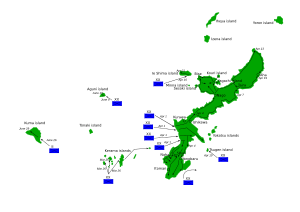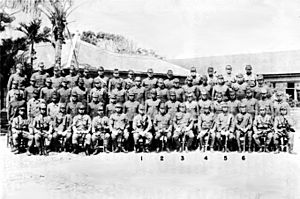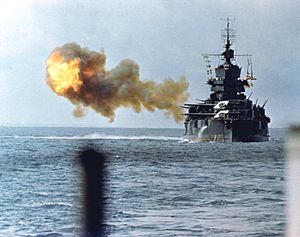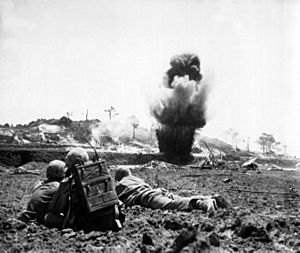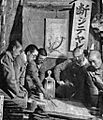Battle of Okinawa facts for kids
Quick facts for kids Battle of Okinawa |
|||||||
|---|---|---|---|---|---|---|---|
| Part of World War II, the Pacific War | |||||||
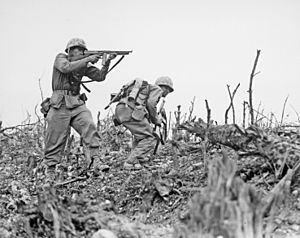 A Marine from the 2nd Battalion, 1st Marines on Wana Ridge provides covering fire with his Thompson submachine gun, May, 1945 |
|||||||
|
|||||||
| Belligerents | |||||||
| Commanders and leaders | |||||||
|
|
|
||||||
| Strength | |||||||
| 183,000 | 117,000 | ||||||
| Casualties and losses | |||||||
| 12,513 killed 38,916 wounded, 33,096 non-combat losses |
About 95,000 killed 7,400–10,755 captured |
||||||
| Estimated 42,000–150,000 civilians killed | |||||||
The Battle of Okinawa was a very important battle during World War II. It happened on Okinawa Island, which is part of the Ryūkyū Islands south of Japan. This battle was fought between the military forces of the Empire of Japan and the Allied forces.
It was the second largest amphibious battle of World War II. This means it involved soldiers landing from the sea onto land. Only the Battle of Normandy was bigger. The Battle of Okinawa was also one of the longest battles in history. It lasted from April to June 1945. The Allies won the battle and took control of Okinawa. Today, Okinawa is part of Japan, but American military bases are still there.
Many people see the Battle of Okinawa as the last major battle of World War II. The Americans were planning a big invasion of Japan's main islands, called Operation Downfall. However, this invasion never happened. Japan surrendered in August 1945 after the United States used atomic bombs on Hiroshima and Nagasaki. The Soviet Union also declared war on Japan around this time.
The battle was so intense that it was called the "Typhoon of Steel" in English. People in Okinawa called it "tetsu no ame" (rain of steel) or "tetsu no bōfū" (violent wind of steel). These names show how much gunfire and bombs were used during the fighting.
Unlike some other battles, like the Battle of Iwo Jima, Okinawa had many regular people living there. A large number of civilians were killed or hurt during the battle. At least 150,000 civilians died or were injured. American forces lost about 18,900 soldiers who were killed or missing. Another 53,000 were injured. This was more than double the number of soldiers killed at Iwo Jima and Guadalcanal combined. About one-third of the island's civilian population was killed.
Around 100,000 Japanese soldiers were killed, and about 7,000 were captured. Some Japanese soldiers took their own lives or used grenades to blow themselves up. Some civilians also took their own lives and their families' lives. This happened because Japanese leaders had spread false information (called propaganda) that Americans would treat prisoners terribly.
In 1945, Winston Churchill, a famous British leader, said the battle was "among the most intense and famous in military history."
Contents
Who Fought in the Battle?
Allied Forces
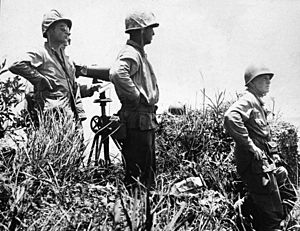
Admiral Raymond A. Spruance was in charge of the overall Allied naval forces. His fleet was divided into different groups.
The largest group was Task Force 56, which included the 10th Army. This army had two main parts, called corps. In total, the 10th Army had over 102,000 Army soldiers. It also had more than 88,000 Marines and 18,000 Navy personnel. These Navy people were mostly Seabees (construction workers) and medical staff.
At the start of the battle, the 10th Army had 182,821 people under its command. The U.S. Navy had more casualties in this battle than in any other during the war.
Japanese Forces
The Japanese land forces, who mainly focused on defending the island, had about 67,000 men. Some sources say this number was closer to 77,000. There were also 9,000 Imperial Japanese Navy (IJN) troops at a naval base. In addition, about 39,000 local Ryukyuan people were forced to fight.
What Happened at Sea?
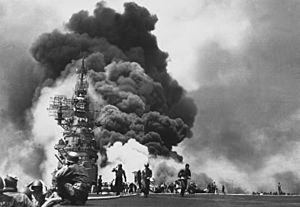
The United States Navy's Task Force 58 was positioned east of Okinawa. It had many ships, including 6 to 8 destroyers and 13 aircraft carriers. Admiral Chester W. Nimitz made sure his naval commanders had time to rest.
At first, Japanese air attacks were not very strong. But on April 6, about 400 planes from Kyūshū attacked. Between March 26 and April 30, 20 American ships were sunk, and 157 were damaged.
The Japanese lost more than 1,100 planes during the battle.
From April 6 to June 22, the Japanese launched 1,465 kamikaze attacks. Kamikaze pilots would intentionally crash their planes into enemy ships. Several large aircraft carriers were badly damaged by these attacks.
Operation Ten-Go
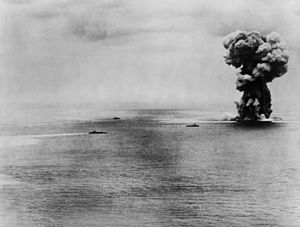
Operation Ten-Go was an attack by ten Japanese ships. The most famous ship was the battleship Yamato, one of the largest battleships ever built. In this operation, the Imperial Japanese Navy lost 3,700 sailors, including Admiral Itō. The U.S. forces lost only 10 aircraft and 12 airmen.
British Pacific Fleet's Role
The British Pacific Fleet also helped in the battle. They were ordered to attack Japanese airfields on the Sakishima Islands. This helped reduce the number of Japanese planes that could attack Allied ships.
The Land Battle on Okinawa
The fighting on land lasted about 81 days, starting on April 1, 1945. The first American soldiers to land were from the 77th Infantry Division. They landed west of Okinawa on March 26.
On March 31, Marines landed on Keise Shima without any fighting.
Fighting in Northern Okinawa
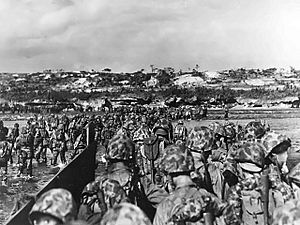
The main landing happened on April 1 on the western coast of Okinawa. The XXIV Corps and III Amphibious Corps led this landing.
The 10th Army moved across the middle-southern part of the island. They quickly captured the Kadena and Yomitan airbases.
Six days later, on April 13, the 2nd Battalion of the 22nd Marine Regiment reached Hedo Point in the northern part of the island. Japanese forces in the north were mainly on the Motobu Peninsula.
The 77th Infantry Division attacked Ie Island on April 16.
Fighting in Southern Okinawa
The U.S. Army's 96th Infantry Division and 7th Infantry Division moved south across Okinawa. The 96th Infantry Division had very tough fights with Japanese troops. The Japanese were hidden in strong, fortified positions.
The Americans had 1,500 soldiers killed or wounded in these fights. They killed or captured about 4,500 Japanese soldiers.
The next American target was Kakazu Ridge. Japanese soldiers were hidden in caves, making them very hard to fight. Many soldiers on both sides were killed or injured here.
On the evening of April 12, the 32nd Army of Japan attacked U.S. positions. The attackers were forced to retreat. Another attack on April 14 was also stopped.
The Americans launched a new attack on April 19. They used 324 guns, which was the largest number ever used in the Pacific Ocean war. Then, 650 Navy and Marine planes attacked with special bombs, rockets, and machine guns.
A tank attack by the Americans failed, and 22 tanks were lost. The XXIV Corps lost 720 men who were killed, wounded, or missing.

On May 4, the Japanese 32nd Army launched another attack. This time, General Ushijima tried to land troops behind American lines. Japanese artillery fired 13,000 rounds. However, this attack also failed.
General Buckner started another American attack on May 11. By the end of May, heavy monsoon rains turned the hills and roads into thick mud, making fighting even harder.
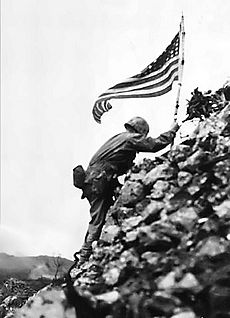
On May 29, Major General Pedro del Valle ordered Company A of the 1st Battalion, 5th Marines to capture Shuri Castle. This castle was a very important Japanese stronghold.
The Japanese forces then retreated. Nearly 30,000 men moved to their last defense line on the Kiyan Peninsula. The 4,000 Japanese sailors there, including Admiral Minoru Ota, all took their own lives.
On June 18, General Buckner was killed by enemy artillery fire. The last organized Japanese resistance ended on June 21. However, some Japanese soldiers stayed hidden and continued fighting for a while.
Images for kids
-
A US Marine Corps Stinson Sentinel observation plane flies over the razed Naha, capital of Okinawa, in May 1945.
-
Overcoming the civilian resistance on Okinawa was aided by US propaganda leaflets, one of which is being read by a prisoner awaiting transport.
-
Marines celebrate Victory over Japan Day on Okinawa, August 1945
-
Japanese high school girls wave farewell to a kamikaze pilot departing to Okinawa
-
Royal Navy Fleet Air Arm Avengers, Seafires and Fireflies on HMS Implacable warm up their engines before taking off.
-
HMS Formidable on fire after a kamikaze attack on May 4. The ship was out of action for fifty minutes.
See also
 In Spanish: Batalla de Okinawa para niños
In Spanish: Batalla de Okinawa para niños


